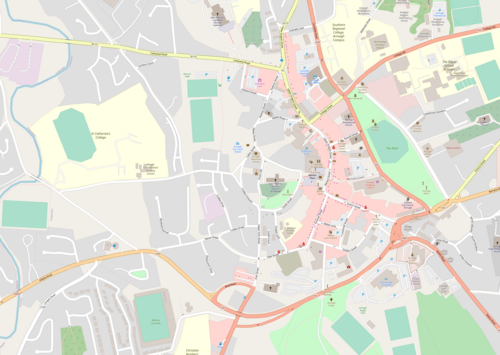Abbreviations and key
| * | current monastic function |
|---|---|
| + | current non-monastic ecclesiastic function |
| ^ | current non-ecclesiastic function |
| = | remains incorporated into later structure |
| # | no identifiable trace of the monastic foundation remains |
| ~ | exact site of monastic foundation unknown |
| ø | possibly no such monastic foundation at location |
| ¤ | no such monastic foundation |
| ≈ | identification ambiguous or confused |
Locations with names in italics indicate probable duplication (misidentification with another location) or non-existent foundations (either erroneous reference or proposed foundation never implemented).
| NIEA | Scheduled Monument (NI) |
| NM | National Monument (ROI) |
| C.I. | Church of Ireland |
| R.C. | Roman Catholic Church |
| Foundation | Image | Communities & provenance | Formal name or dedication & alternative names | References & location |
|---|---|---|---|---|
| Armagh Abbey | Augustinian Canons Regular founded before 1126, consecrated by Archbishop Cellach 1126; refounded 1134; Augustinian Canons Regular — Arroasian adopted c. 1140 at the instigation of St Malachy; dissolved 1562; re-established | SS Peter and Paul | [1] 54°20′58″N6°39′22″W / 54.349434°N 6.656134°W (approx) | |
| Armagh Blackfriarsø | suggested community of Dominican Friars purportedly founded c. 1264 by Patrick O'Scanlon; evidence lacking | |||
| Armagh Priory of Culdees | Culdees founded before 779 | Ard-macha Altum Machae; Emain-Macha; Druim Saillech | [2] 54°20′49″N6°39′25″W / 54.347042°N 6.657071°W (approx) | |
| Armagh Temple-na-Ferta ?Abbey | Gaelic nuns founded 5th century by St Patrick; Augustinian Cannonesses Regular — Arroasian? apparently refounded c. 1144?; dissolved 1562?; granted to Francis Annesley, Esq. by King James 1618 | Temple Fortagh | [3] [4] 54°20′49″N6°39′07″W / 54.346837°N 6.651929°W (approx) | |
| Armagh Temple Brigid ?Priory | Gaelic nuns dependent on Temple-na-Ferta founded 5th century by St Patrick; Augustinian Cannonesses Regular — Arroasian? apparently refounded c. 1144?; dissolved 1562? | Templebreed Priory | [5] 54°20′51″N6°39′17″W / 54.347428°N 6.654755°W (approx) | |
| Armagh Friary # |  | Franciscan Friars founded 1263/4-1551 by Archbishop Patrick O’Scannail; dissolved 1542, though some religious life continued; buildings were used for welfare purposes later in the 16th century; ruinous by 1600 | [6] 54°20′38″N6°39′11″W / 54.3439526°N 6.6531836°W | |
| Armagh Abbey of Columcille | founded before 1010; noted as St Columba’s Church – Rocque’s 1760 map of Armagh | Templecolumkilly in Bore-netrian-sassenach | [7] 54°20′59″N6°39′24″W / 54.349778°N 6.656542°W (approx) | |
| Ballymoyer Monastery ≈ | early monastic site, founded by St Patrick, [notes 1] possibly Tehallan, County Monaghan [notes 2] | Baile-mac-maier; Ballymyre; Tech-talain?; Tahellen? | [8] [9] [10] 54°13′02″N6°31′22″W / 54.217138°N 6.522868°W | |
| Creggan | Franciscan Friars, First Order — place of refuge | Cregan | [11] [12] 54°04′57″N6°34′34″W / 54.08251°N 6.57600°W (approx) | |
| Derrynoose Monastery ~ | early monastic site, founded 6th century by Mochua of Dairinis; later Culdees of Armagh also suggested to be located in County Cavan [notes 3] | Dairinis; Derinish; Derenoyse; Toaghy | [13] [14] 54°13′57″N6°47′04″W / 54.232500°N 6.784410°W | |
| Eglish Monastery | early monastic site; remains of two high crosses on site [notes 4] | Eglais | [15] 54°23′39″N6°45′35″W / 54.3941492°N 6.7597248°W | |
| Killevy Friary≈¤ | Franciscan Friars, Third Order Regular actually Killeenbrenan, County Mayo — the house at Killevy being a convent of nuns | Kilslere Friary | ||
| Killevy Abbey |  | Gaelic nuns (community founded c. 484 at Faughart; transferred to Beg-erin, County Wexford) transferred from Beg-erin: founded c. 500 (517) by St Moninna (Darerca); Augustinian Cannonesses Regular — Arroasian? refounded after 1171? C.I. parish church built on site | Cell Sleibe Cuilin; Cell-shleibe; Cell-shleibe-mor-Cuillin; Mons-Cuillinn; Kilsleve; Belslebhe; Killeavy | [16] 54°08′14″N6°24′33″W / 54.1371511°N 6.4092696°W |
| Kill-unche Monastery ~ | founded by St Nectan in reg. Conalliae Murthemhne, possibly located in County Armagh | |||
| Kilmore Monastery | early monastic site, founded by St Mochta burned 749; also identified as Kilmore, County Monaghan; Church of Ireland church built on site | Cellmor-einer; Cellmor-muighe-emhir; Cellmor-Ua-Niallain; Cellmor-inir; Cellmor-Aedhan; Kilmore Aedhan; cell-mor; Cella Magna?; Lismor?; Killmor-Aedhan? | [17] 54°24′01″N6°32′53″W / 54.400167°N 6.548060°W | |
| Kilnasaggart Monastery # | site occupied by the Kilnasaggart Stone | Ternocc mac Ciarain dećc; i Cill na Saccart | [18] [19] 54°04′18″N6°22′46″W / 54.071695°N 6.379361°W (approx) | |
| Mullaghbrack | Armagh Culdees – the Prebendary of Mullaghbrack | Mullach Breac | [20] [21] 54°19′13″N6°31′40″W / 54.320320°N 6.527912°W | |
| Seagoe Monastery | early monastic site, founded by St Gobhan, abbot | Suidhe Gobha; Tech-da-Gobha; Tegh-da-Gobha | [22] 54°26′15″N6°25′28″W / 54.437372°N 6.424319°W | |
| Straidbail-Loyse Friary≈ | given as friary of Franciscans founded 1282; probable mistaken reference to Stradbally, County Laois | |||
| Tartaraghan | Grange of the Abbey of St. Peter and St. Paul in Armagh | [23] [24] [25] 54°26′59″N6°33′12″W / 54.449666°N 6.553284°W | ||
| Tassagh Priory | Culdees, dependent on Armagh and Derrynoose; St Tassach? Culdee cemetery | Ballintassa; Tassaghowtragh | [26] [27] 54°16′50″N6°40′20″W / 54.28058°N 6.67232°W | |
| Tech-fethgnai Monastery | early monastic site, possibly a cell near Armagh monastery, founded by Mael-muire, erenagh | |||
| Tynan Abbey # | Gaelic monks founded before 1072; mansion named Fairview built on site c. 1750; remodelled in the monastic-gothic style, residence of the Stronge family; part in use by the Royal Ulster Constabulary from 1923; bombed by the IRA 21 January 1981; demolished 1998 | Tiudhnidha; Tuidnigha | [28] 54°19′52″N6°49′23″W / 54.331°N 6.823°W | |


